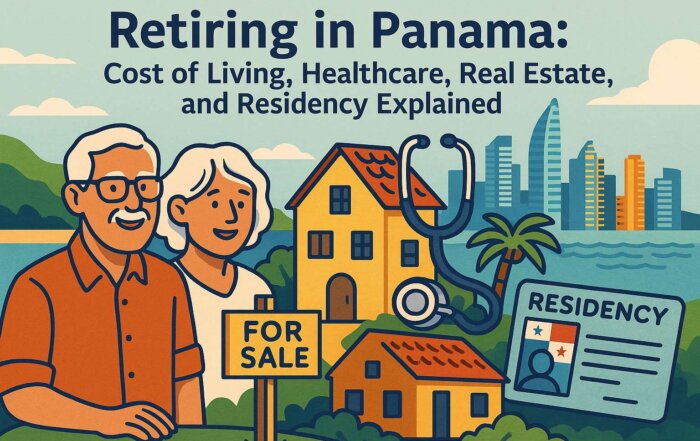
Visiting an Emberá-Wounaan Village
Visiting an Emberá-Wounaan village is an experience you’ll never forget. Whether you’re visiting Panamá on a fact-finding trip with a view to finding real estate or you’re already a resident, this is a trip you must find time for.
Bouncing along the bumpy, windy, jungle road with Panama City in the rear-view mirror we’re always filled with a sense of excitement as we approach an Emberá community situated on the banks of the Chagres River. The Emberá-Wounaan are one of Panama’s principal indigenous groups, living primarily in Panama’s Darien Province. The Emberá have about 30,000 members in Panamá and another 50,000 across the border in Colombia. They have their own distinct language, customs, dress, and traditions.
Going to see a local tribe starts with that bumpy journey to the boat launch – when you’re there don’t be expecting some fancy boat with bells and whistles because your ‘crew’ are going to collect you wearing their intricately beaded loincloths and traditional jewelry astride their long, carved canoes, and your experience will be all the better for it! It’s incredible!
The simple wooden Emberá canoe has you all sat in a line on little wooden benches while one tribesman steers and controls the motor and one at the front has a large stick ready to drag you over the rocks along sections of shallow water.

You’ll bump and wind down the Chagres River a variable distance depending on your tour as there are different Emberá communities to visit along the way. The journey is beautiful as the river is surrounded by the Chagres National Park. You’ll see birds, butterflies, and possibly even some monkeys (depending on the time of your trip). Upon arrival at the community the tribe greet you with panpipes, bongos, and all kinds of interesting hand-carved instruments including a full turtle shell. The Emberá children laugh, jump, and run around in and out of the water as you’re guided into the main meeting hut.

A brief overview of the Emberá-Wounaan
The Emberá-Wounaan are indigenous peoples who primarily inhabit the rainforests of Panama and Colombia. In Panama, the Emberá-Wounaan reside in the eastern and western regions of the country, particularly in the provinces of Darién, Panama, and Panama Oeste.
The Emberá-Wounaan autonomous area was created in 1983 from two enclaves located in the Darién Province, specifically the districts of Chepigana and Pinogana. Its capital is Unión Chocó.
During the colonial era both the Embera ethnic group and the Wounaan ethnic group were known by other names, such as: citars, zirambiraes, citabiraes, chocoes, among others. They entered the isthmus around the 18th century from the Chocó region in Colombia. The latest studies indicate that they may have occupied lands in Pre-Colombian Brazil.

The history of the Emberá-Wounaan people is rich and complex, shaped by centuries of existence in the rainforests of Panama and Colombia. While a comprehensive account of their history is challenging due to limited written records, archaeological evidence, oral traditions, and anthropological studies provide insights into their past.
Pre-Columbian Era:
The Emberá-Wounaan have deep historical roots, and evidence suggests their presence in the region long before the arrival of Europeans. They likely inhabited the rainforests of present-day Panama and Colombia for centuries, living in harmony with nature and relying on subsistence activities.
Encounter with Europeans:
The Emberá-Wounaan, like many indigenous peoples, encountered European explorers and colonizers during the Age of Exploration. The arrival of the Spanish in the early 16th century marked a significant turning point in their history.
Contact with Europeans brought about significant changes in the Emberá-Wounaan way of life, including exposure to new diseases, cultural suppression and assimilation, alterations in trade patterns, land displacement and exploitation, and aggressive conflict with colonial powers.
Colonial Period:
During the colonial period, the Emberá-Wounaan, like many indigenous groups, faced immense challenges as European powers sought to exert control over the territories they inhabited. The disruption caused by colonization impacted their traditional social structures and ways of living.
Resistance and Adaptation:
The Emberá-Wounaan, resilient and adaptive, often engaged in resistance against colonial forces. Some groups withdrew deeper into the rainforest to maintain their traditional lifestyles and evade external pressures.
Over time, the Emberá-Wounaan developed strategies for coexistence and trade with non-indigenous communities, adapting to the changing socio-political landscape.
Contemporary Challenges:
In the modern era, Emberá-Wounaan communities continue to face challenges such as land encroachment, environmental degradation, and limited access to education and healthcare. Efforts by the governments of Panama and Colombia, as well as various NGOs, aim to address these challenges and promote the rights and well-being of indigenous peoples.
Cultural Preservation:
The Emberá-Wounaan place a strong emphasis on preserving their cultural heritage. Traditional practices, including art, music, and ceremonies, play a crucial role in maintaining a sense of identity and connection to their ancestral roots.
Efforts to document and revitalize the Emberá-Wounaan languages, as well as initiatives to sustain traditional crafts and rituals, contribute to the ongoing preservation of their cultural legacy.
The history of the Emberá-Wounaan people reflects a dynamic interplay of continuity and adaptation, resilience in the face of challenges, and a deep-rooted connection to the rainforest that has been their home for generations. As they navigate the complexities of the modern world, the Emberá-Wounaan continue to play a vital role in the cultural tapestry of Panama and Colombia.

Back to the visit…
Now don’t be of the impression that these communities have never seen an iPhone before or will be shocked by your brand new sneakers, although this is a legitimate experience and window into their lives, there’s every chance once you’ve left, they’ll be relaxing in t-shirt, shorts and flipflops while sending a WhatsApp, but all of their traditions are real, exciting and authentic and you’re in for a treat.
You’ll be ushered into a performance area, a beautiful basic roof structure covered in gorgeous palm leaves. While there you’ll receive a warm welcome and introduction to tribal life, explaining the history of the tribe and how they came to be where they are from the Darien all those years ago.
Hopefully your tour comes with lunch because… The food! Oh my, the food! It’s a fish lover’s dream! When it’s time for lunch you’ll be presented with a folded over banana leaf that is a work of art as much as it is a practical pouch for all things lunch. Tucked inside you’ll be delighted to discover piping hot breaded talapia or peacock bass, crunchy patacones and a wedge of fresh orange or lime. It’s a taste sensation – lunch with the tribe is worth the modest entrance fee in itself!
Top tip #1
Take plenty of water with you, the heat and humidity in the Chagres National Park are high and you’ll need to stay hydrated.
Top tip #2
Take cash, as you’ll want to buy their incredible homemade arts and crafts. There are woven baskets, jewelry, fabric skirts – all made using natural dyes. There are also carved figures made from local nuts and wood. They are incredibly resourceful in using the natural habitat around them to make their wares. Another fun option is to get one of their very cool non-permanent tribal tattoos, done using a black dye made from a local plant, jagua, and it usually lasts about a week.
The tribal men will then perform traditional tunes on their handmade instruments while the women perform traditional dances. And when it’s time to dance and your feet are tap-tapping along to the beat, don’t fight the urge just get up there and give it everything you’ve got, they love it when you join in!
When it’s time to say goodbye, you get back in your canoe for the beautiful return trip to Gamboa. Last time we went it absolutely poured down with rain for the return journey so Top Tip #3 would be to take a poncho, or coat with you just in case the weather takes a turn for the worse!
Even with a downpour, nothing can dampen your spirits after a day at the Embera village, this is truly an amazing memory you’ll cherish from your Panama travels.
If you’re interested in exploring more of what Panama City has to offer, we’ve got some awesome day-trip recommendations for you! Check them out below. Don’t hesitate to let us know if you have any questions or if there’s anything else we can help with. Happy travels!














